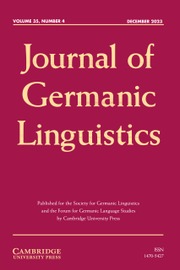No CrossRef data available.
Article contents
Perception and Asymmetry in the High German Consonant Shift
Published online by Cambridge University Press: 03 October 2024
Abstract
This article addresses the shift asymmetries of the High German Consonant Shift. In one part of this sound change, Pre-Old High German ⁺/p/, ⁺/t/, and ⁺/k/ shifted to the Old High German affricates [pf], [ts], and [kx], respectively. However, the voiceless stops did not shift in every dialect of Old High German. The uneven distribution of the shift is referred to in the literature as shift asymmetry. Much work by Iverson, Davis, and Salmons has attributed the asymmetry to markedness. While maintaining their overall analysis of the shift, this article shows that markedness can be dispensed with in accounting for the shift asymmetries. In accordance with Evolutionary Phonology, perceptual and phonetic data are presented which account for the asymmetries without making any reference to markedness. Since it rejects markedness in diachronic sound change, the present analysis also has broader implications for markedness diachronically and synchronically.
- Type
- Articles
- Information
- Copyright
- © The Author(s), 2024. Published by Cambridge University Press on behalf of Society for Germanic Linguistics



